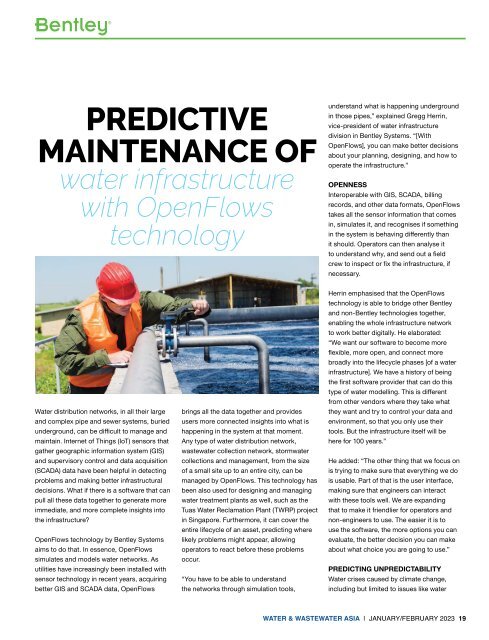Water & Wastewater Asia January/February 2023
Water & Wastewater Asia is an expert source of industry information, cementing its position as an indispensable tool for trade professionals in the water and wastewater industry. As the most reliable publication in the region, industry experts turn this premium journal for credible journalism and exclusive insight provided by fellow industry professionals. Water & Wastewater Asia incorporates the official newsletter of the Singapore Water Association (SWA).
Water & Wastewater Asia is an expert source of industry information, cementing its position as an indispensable tool for trade professionals in the water and wastewater industry. As the most reliable publication in the region, industry experts turn this premium journal for credible journalism and exclusive insight provided by fellow industry professionals. Water & Wastewater Asia incorporates the official newsletter of the Singapore Water Association (SWA).
Create successful ePaper yourself
Turn your PDF publications into a flip-book with our unique Google optimized e-Paper software.
PREDICTIVE<br />
MAINTENANCE OF<br />
water infrastructure<br />
with OpenFlows<br />
technology<br />
understand what is happening underground<br />
in those pipes,” explained Gregg Herrin,<br />
vice-president of water infrastructure<br />
division in Bentley Systems. “[With<br />
OpenFlows], you can make better decisions<br />
about your planning, designing, and how to<br />
operate the infrastructure.”<br />
OPENNESS<br />
Interoperable with GIS, SCADA, billing<br />
records, and other data formats, OpenFlows<br />
takes all the sensor information that comes<br />
in, simulates it, and recognises if something<br />
in the system is behaving differently than<br />
it should. Operators can then analyse it<br />
to understand why, and send out a field<br />
crew to inspect or fix the infrastructure, if<br />
necessary.<br />
<strong>Water</strong> distribution networks, in all their large<br />
and complex pipe and sewer systems, buried<br />
underground, can be difficult to manage and<br />
maintain. Internet of Things (IoT) sensors that<br />
gather geographic information system (GIS)<br />
and supervisory control and data acquisition<br />
(SCADA) data have been helpful in detecting<br />
problems and making better infrastructural<br />
decisions. What if there is a software that can<br />
pull all these data together to generate more<br />
immediate, and more complete insights into<br />
the infrastructure?<br />
OpenFlows technology by Bentley Systems<br />
aims to do that. In essence, OpenFlows<br />
simulates and models water networks. As<br />
utilities have increasingly been installed with<br />
sensor technology in recent years, acquiring<br />
better GIS and SCADA data, OpenFlows<br />
brings all the data together and provides<br />
users more connected insights into what is<br />
happening in the system at that moment.<br />
Any type of water distribution network,<br />
wastewater collection network, stormwater<br />
collections and management, from the size<br />
of a small site up to an entire city, can be<br />
managed by OpenFlows. This technology has<br />
been also used for designing and managing<br />
water treatment plants as well, such as the<br />
Tuas <strong>Water</strong> Reclamation Plant (TWRP) project<br />
in Singapore. Furthermore, it can cover the<br />
entire lifecycle of an asset, predicting where<br />
likely problems might appear, allowing<br />
operators to react before these problems<br />
occur.<br />
“You have to be able to understand<br />
the networks through simulation tools,<br />
Herrin emphasised that the OpenFlows<br />
technology is able to bridge other Bentley<br />
and non-Bentley technologies together,<br />
enabling the whole infrastructure network<br />
to work better digitally. He elaborated:<br />
“We want our software to become more<br />
flexible, more open, and connect more<br />
broadly into the lifecycle phases [of a water<br />
infrastructure]. We have a history of being<br />
the first software provider that can do this<br />
type of water modelling. This is different<br />
from other vendors where they take what<br />
they want and try to control your data and<br />
environment, so that you only use their<br />
tools. But the infrastructure itself will be<br />
here for 100 years.”<br />
He added: “The other thing that we focus on<br />
is trying to make sure that everything we do<br />
is usable. Part of that is the user interface,<br />
making sure that engineers can interact<br />
with these tools well. We are expanding<br />
that to make it friendlier for operators and<br />
non-engineers to use. The easier it is to<br />
use the software, the more options you can<br />
evaluate, the better decision you can make<br />
about what choice you are going to use.”<br />
PREDICTING UNPREDICTABILITY<br />
<strong>Water</strong> crises caused by climate change,<br />
including but limited to issues like water<br />
WATER & WASTEWATER ASIA | JANUARY/FEBRUARY <strong>2023</strong> 19


















